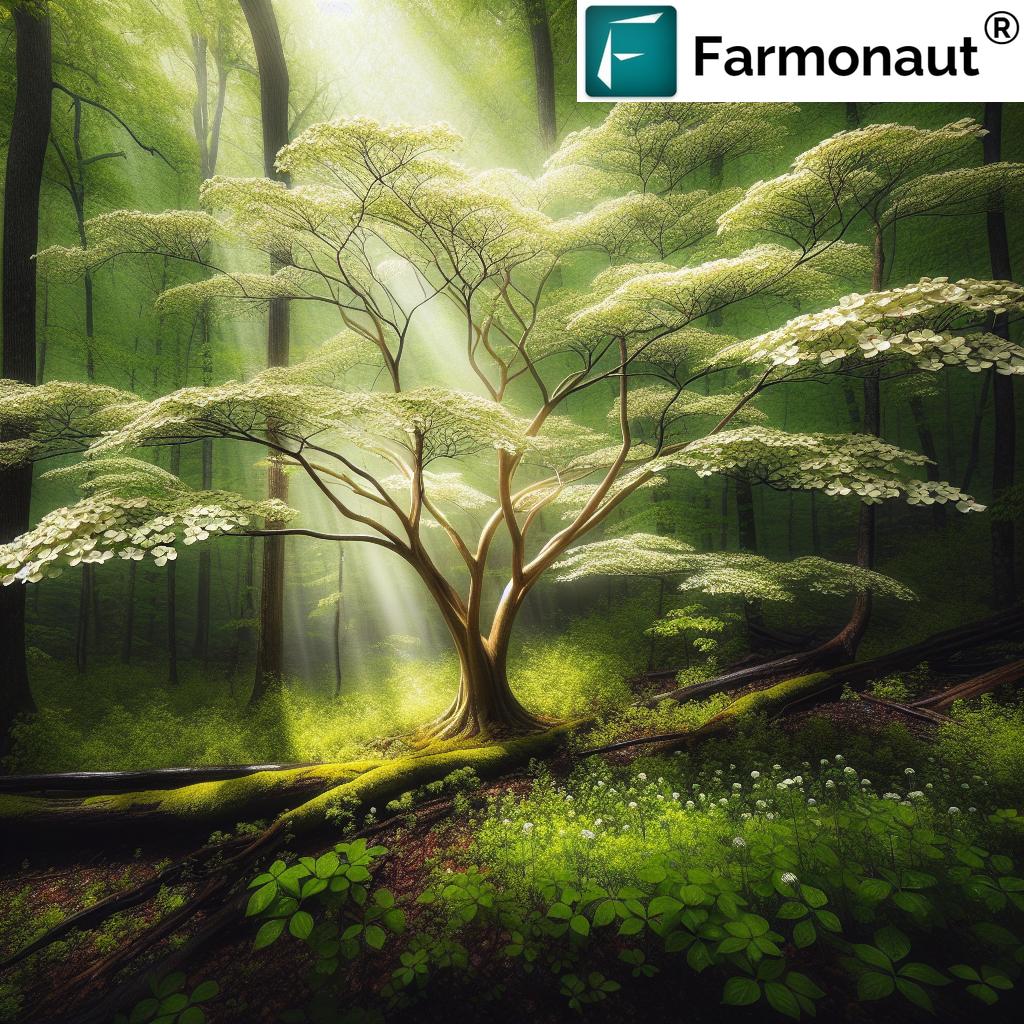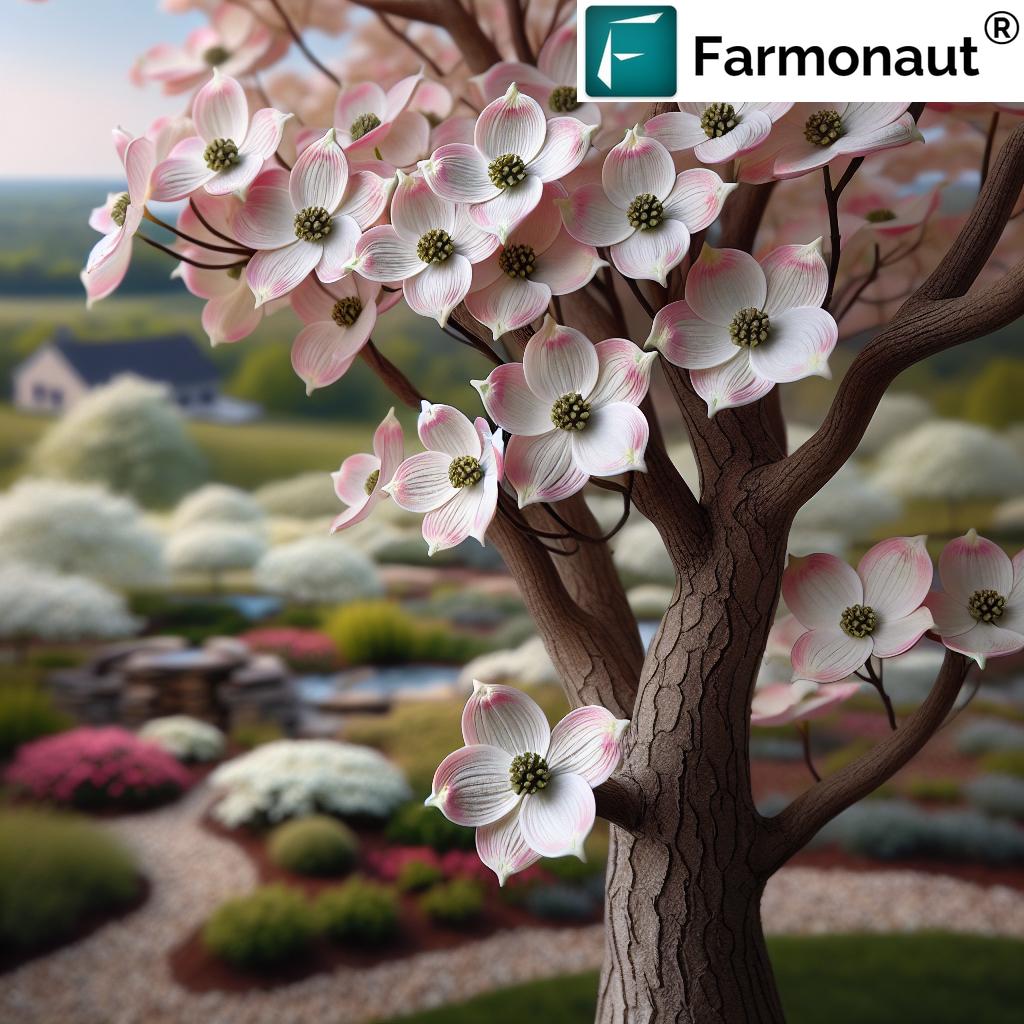Discover Missouri’s State Tree: A Guide to Planting and Caring for Flowering Dogwoods in Your Ozark Landscape

“The flowering dogwood has been Missouri’s state tree for over 65 years, since its designation in 1955.”
Welcome to our comprehensive guide on the flowering dogwood, Missouri’s beloved state tree. As we approach the 70th anniversary of its official designation in 2025, we’re excited to share our knowledge and passion for this iconic species. Whether you’re a seasoned horticulturist or a novice gardener, this guide will provide you with valuable insights into selecting, planting, and nurturing dogwood trees in your Ozark landscape.
The Flowering Dogwood: Missouri’s Natural Gem
The flowering dogwood (Cornus florida) has been an integral part of Missouri’s natural heritage for centuries. Its stunning white and pink blooms have graced our Ozark woodlands long before it was officially recognized as the state tree in 1955. These hardy, shade-tolerant beauties are not just aesthetically pleasing; they play a crucial role in our native ecosystems.
As we delve into the world of dogwoods, we’ll explore their historical significance, biological characteristics, and the best practices for incorporating them into your landscape. We’ll also touch on how modern technology, such as satellite-based monitoring systems like those offered by Farmonaut, can aid in the care and management of your garden or larger agricultural projects.
The Beauty of Dogwood Blooms
One of the most captivating features of the flowering dogwood is, undoubtedly, its blooms. These flowers, which typically appear from mid-April to early May, transform the Ozark woodlands into a spectacular canvas of white and pink. What many people don’t realize is that what we perceive as the dogwood’s “petals” are actually bracts – modified leaves that surround the true flowers, which are small and greenish-yellow.
The dogwood’s flowering period is relatively short but intense, earning it the nickname “nature’s little showoff” among horticulturists. This brief but brilliant display makes the dogwood a favorite for gardeners who want to add a touch of spring magic to their landscapes.
Dogwood Varieties: A Palette of Colors and Forms
While the native white-flowering dogwood is the most common, there are several cultivars available that offer a range of colors and forms. Let’s explore some popular varieties:
| Cultivar Name | Flower Color | Bloom Time | Mature Height | Special Features |
|---|---|---|---|---|
| Cherokee Princess | White | Early Spring | 15-25 feet | Large flowers, prolific bloomer |
| Red Beauty | Dark Rosy-Red | Mid-Spring | 15-20 feet | Semi-dwarf, intense color |
| Cloud 9 | White | Early Spring | 15-20 feet | Heavy bloomer, compact form |
| Cherokee Chief | Deep Ruby-Red | Mid-Spring | 20-25 feet | Vibrant color, upright growth |
| Cherokee Daybreak | White | Mid-Spring | 15-20 feet | Variegated foliage |
These cultivars offer a range of options for your landscape, from the classic white of ‘Cherokee Princess’ to the vibrant reds of ‘Cherokee Chief’ and ‘Red Beauty’. The variegated foliage of ‘Cherokee Daybreak’ adds interest even when the tree is not in bloom.
Planting Your Dogwood: A Step-by-Step Guide
Now that we’ve explored the various dogwood cultivars, let’s dive into the process of planting these beautiful trees in your Ozark landscape. Follow these steps to ensure your dogwood gets off to the best possible start:
- Choose the right location: Dogwoods prefer partial shade, especially protection from the hot afternoon sun. They thrive in moist, well-drained soils rich in organic matter.
- Prepare the soil: Loosen the soil to a depth of 8-12 inches in an area two to three times the diameter of the tree’s root ball.
- Plant at the right depth: Ensure the tree is planted no deeper than it was in the nursery container. The root flare should be slightly above ground level.
- Backfill and water: Fill the hole with the original soil, mixed with some organic matter if needed. Water thoroughly to eliminate air pockets.
- Mulch: Apply a 2-3 inch layer of mulch around the base of the tree, keeping it away from the trunk to prevent rot.

Remember, proper planting is crucial for the long-term health and success of your dogwood tree. If you’re managing a larger property or agricultural project, consider using advanced tools like Farmonaut’s crop plantation and forest advisory services to optimize your planting strategies and monitor tree health.
Caring for Your Dogwood: Essential Tips
Once your dogwood is planted, it’s important to provide proper care to ensure its health and longevity. Here are some essential care tips:
- Watering: Water deeply and regularly during the first two growing seasons. Once established, dogwoods are relatively drought-tolerant but benefit from occasional deep watering during dry spells.
- Fertilizing: Apply a balanced, slow-release fertilizer in early spring. Avoid over-fertilizing, as this can lead to excessive leaf growth at the expense of flowers.
- Pruning: Prune in late winter or early spring before new growth begins. Remove dead, diseased, or crossing branches to improve air circulation and tree structure.
- Pest and disease management: Monitor for common issues like dogwood anthracnose and dogwood borer. Maintain good air circulation and avoid overhead watering to prevent fungal diseases.
“Dogwood trees typically reach heights of 20-30 feet, making them ideal for small to medium-sized landscapes.”
For those managing larger landscapes or agricultural projects, integrating technology can significantly enhance your tree care efforts. Farmonaut’s carbon footprinting service can help you understand and optimize the environmental impact of your landscaping practices, ensuring sustainable management of your dogwood trees and overall property.
The Ecological Importance of Dogwoods
Dogwood trees are not just beautiful additions to our landscapes; they play a crucial role in our native ecosystems. Here’s why dogwoods are ecologically important:
- Wildlife habitat: The dense branching structure of dogwoods provides nesting sites for various bird species.
- Food source: The tree’s berries are an important food source for birds and small mammals, especially in late summer and fall.
- Pollinator attraction: The flowers attract bees, butterflies, and other pollinators, supporting local biodiversity.
- Understory health: As an understory tree, dogwoods contribute to the overall health and diversity of forest ecosystems.
By planting dogwoods in your landscape, you’re not just adding beauty; you’re contributing to the ecological health of your local environment. For those interested in large-scale ecological projects, Farmonaut’s large-scale farm management tools can help monitor and manage extensive plantings, ensuring optimal growth and environmental benefits.
Dogwoods in Missouri Culture and History
The flowering dogwood holds a special place in Missouri’s cultural heritage. Its designation as the state tree in 1955 was a recognition of its longstanding importance to the people of Missouri. Here are some interesting historical and cultural aspects of the dogwood in Missouri:
- Native American use: Indigenous peoples used dogwood wood for tools and medicinal purposes long before European settlement.
- Pioneer significance: Early settlers recognized the blooming of dogwoods as a sign that it was time to plant crops.
- Folklore and legend: The dogwood is associated with various legends, including the Christian story of the crucifixion.
- Economic importance: Dogwood timber has been used in various industries, from textile shuttle making to golf club heads.
Understanding the historical and cultural significance of dogwoods adds depth to our appreciation of these trees. It reminds us that when we plant a dogwood, we’re not just adding a tree to our landscape; we’re continuing a long tradition of valuing and nurturing this important species.
Incorporating Dogwoods into Your Landscape Design
Dogwoods are versatile trees that can enhance various landscape designs. Here are some ideas for incorporating dogwoods into your Ozark landscape:
- Focal point: Plant a single dogwood as a specimen tree in a prominent location in your yard.
- Woodland garden: Create a naturalistic setting by planting dogwoods alongside other native understory plants.
- Border or screen: Plant a row of dogwoods to create a beautiful, flowering border or privacy screen.
- Mixed shrub border: Combine dogwoods with azaleas, rhododendrons, and other spring-flowering shrubs for a spectacular display.
- Container planting: Smaller dogwood varieties can be grown in large containers for patios or small gardens.
When designing your landscape, consider using modern tools to optimize your planning. Farmonaut’s fleet management solutions can help landscaping businesses efficiently manage their resources and equipment, ensuring smooth operations in large-scale planting projects.
Common Challenges and Solutions in Dogwood Care
While dogwoods are generally hardy trees, they can face certain challenges. Here are some common issues and how to address them:
- Dogwood anthracnose: This fungal disease can be severe. Ensure good air circulation, avoid overhead watering, and consider resistant cultivars.
- Dogwood borer: These pests can damage the trunk. Keep trees healthy and avoid injury to the bark.
- Leaf scorch: This can occur in full sun. Ensure adequate watering and mulching, or consider relocating the tree to a shadier spot.
- Poor flowering: This can be due to insufficient light or over-fertilization. Ensure the tree receives enough filtered sunlight and avoid excessive nitrogen.
For those managing larger properties or agricultural projects, early detection of these issues is crucial. Farmonaut’s crop loan and insurance services can provide valuable support in managing the financial risks associated with tree care and agriculture, ensuring you’re protected against unexpected losses.
The Future of Dogwoods in Missouri
As we look to the future, the importance of dogwoods in Missouri’s landscapes and ecosystems remains strong. However, challenges such as climate change and urban development may impact these beloved trees. Here’s how we can ensure a bright future for dogwoods in Missouri:
- Conservation efforts: Support local initiatives to protect native dogwood populations in natural areas.
- Research and development: Stay informed about new, disease-resistant cultivars developed through horticultural research.
- Sustainable practices: Adopt environmentally friendly landscaping practices that support the health of dogwoods and other native species.
- Education: Participate in or support educational programs that teach the importance of native trees like dogwoods.
For those involved in larger-scale agricultural or forestry projects, staying ahead of environmental changes is crucial. Farmonaut’s traceability solutions can help in monitoring and managing large plantings of dogwoods and other species, ensuring their health and sustainability for future generations.
Conclusion: Celebrating Missouri’s Natural Heritage
As we conclude our journey through the world of flowering dogwoods, we hope you’ve gained a deeper appreciation for Missouri’s state tree. From its stunning spring blooms to its crucial role in our ecosystems, the dogwood truly embodies the beauty and resilience of Missouri’s natural heritage.
Whether you’re planting a single tree in your backyard or managing a large-scale landscape project, remember that each dogwood you nurture contributes to the continuation of a long and cherished tradition in our state. By following the care guidelines we’ve outlined and staying informed about modern horticultural practices, you can ensure that these beautiful trees continue to thrive for generations to come.
As we look to the future, let’s commit to being stewards of our natural environment, starting with the humble yet magnificent dogwood. Together, we can ensure that the flowering dogwood remains a symbol of Missouri’s natural beauty and ecological diversity for many more decades to come.
FAQs About Flowering Dogwoods
- When is the best time to plant a dogwood tree?
The best time to plant dogwoods is in the fall or early spring when the tree is dormant. - How often should I water my newly planted dogwood?
Water deeply once or twice a week during the first growing season, ensuring the soil stays moist but not waterlogged. - Can dogwoods grow in full sun?
While dogwoods prefer partial shade, some cultivars can tolerate full sun if given adequate water and care. - How long does it take for a dogwood to bloom after planting?
Dogwoods typically start blooming 3-5 years after planting, depending on the cultivar and growing conditions. - Are dogwoods deer-resistant?
Unfortunately, dogwoods are not deer-resistant and may require protection in areas with high deer populations.
For more information on caring for your dogwood trees or managing larger agricultural projects, consider exploring Farmonaut’s range of services:
Earn With Farmonaut: Affiliate Program
Earn 20% recurring commission with Farmonaut’s affiliate program by sharing your promo code and helping farmers save 10%. Onboard 10 Elite farmers monthly to earn a minimum of $148,000 annually—start now and grow your income!
















